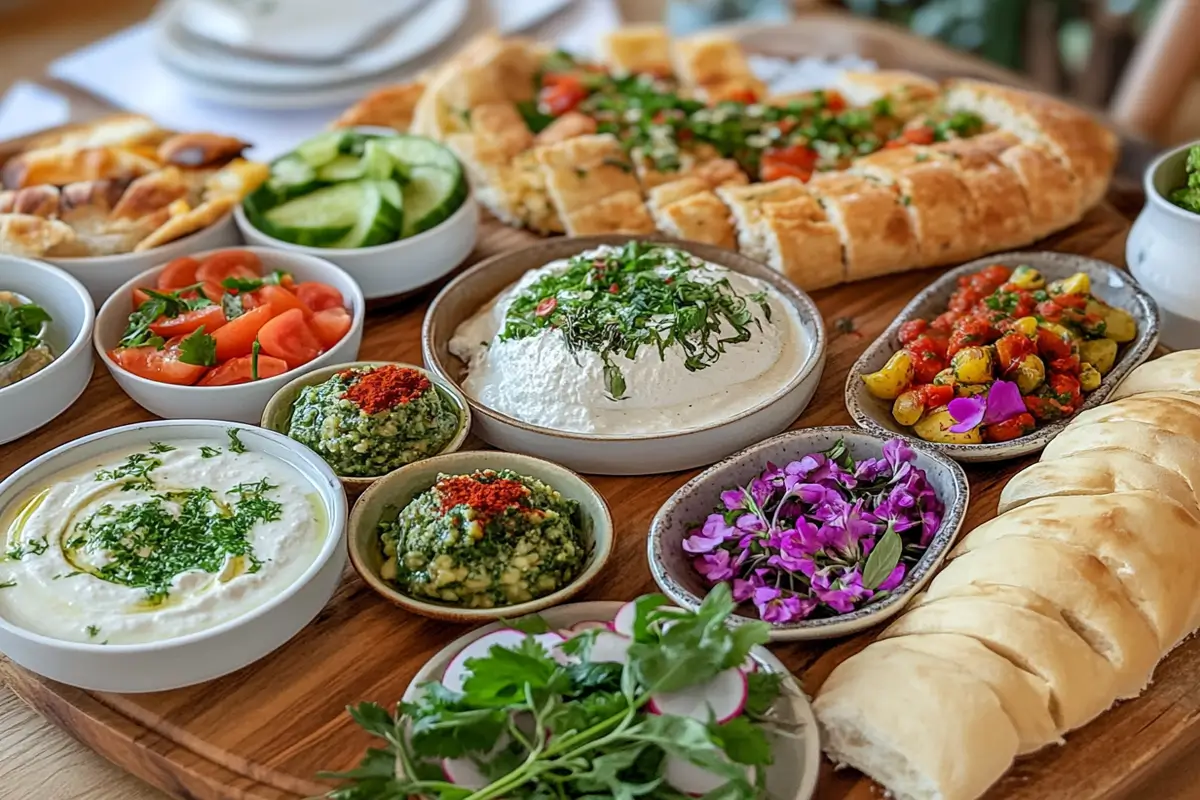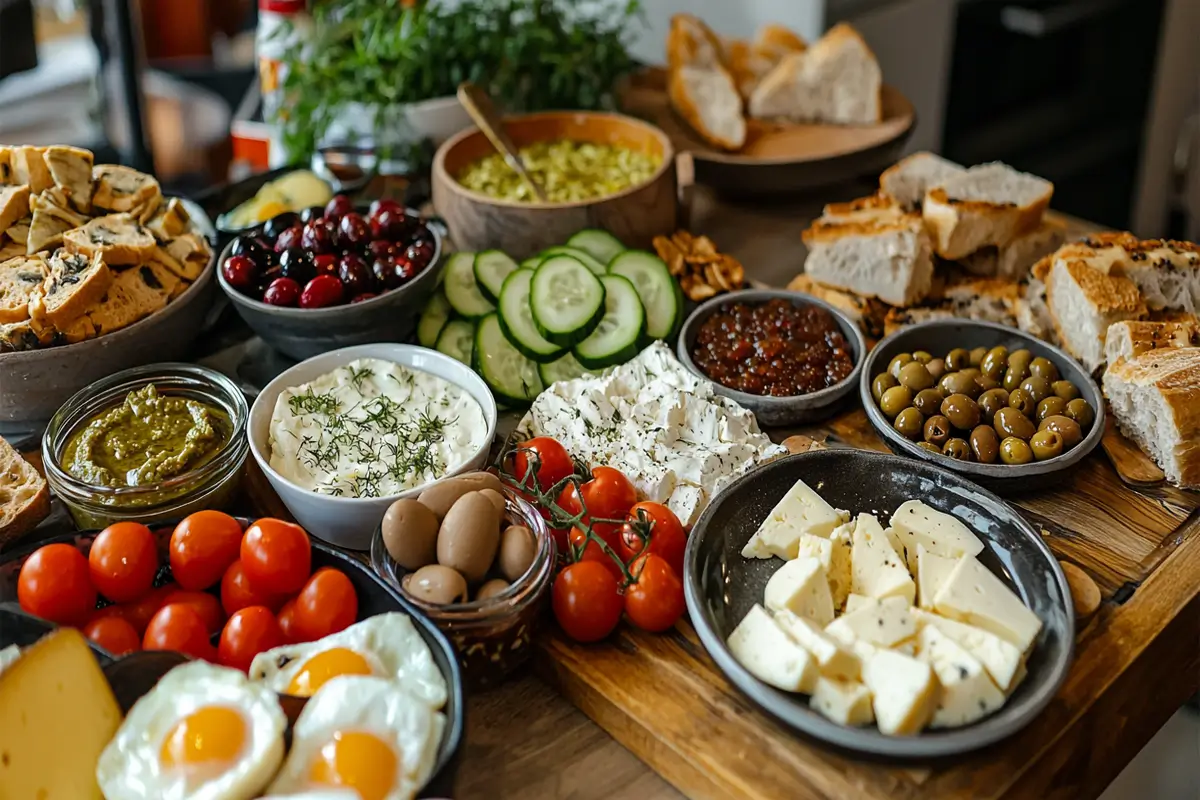Imagine starting your day with a vibrant, flavorful spread that awakens your senses and transports you to the heart of Turkey. That’s the magic of Turkish breakfast, a feast renowned for its variety, freshness, and communal spirit. More than just a meal, it’s a cultural experience, a symphony of tastes and textures designed to be savored and shared. In this guide, we’ll embark on a culinary journey to explore the essential components of a traditional Turkish breakfast, offering you everything you need to recreate this delightful tradition in your own home. Prepare to be captivated by the abundance and warmth of Turkish breakfast!

What is Turkish Breakfast?
A Cultural and Culinary Tradition
Turkish breakfast, or “kahvaltı,” is more than just a meal; it’s a cherished social tradition in Turkey. It represents a time for families and friends to come together, share stories, and enjoy a leisurely start to the day. The emphasis is on variety and abundance, with numerous small dishes creating a colorful and inviting spread.
Key Components of a Traditional Turkish Breakfast
A traditional Turkish breakfast typically includes a selection of cheeses, olives, fresh tomatoes and cucumbers, jams, honey, eggs, and an assortment of breads. Spreads and dips like acuka and tahini pekmez add unique flavors. Turkish tea, served in delicate tulip-shaped glasses, is an essential component, providing warmth and comfort.
Essential Elements of a Turkish Breakfast
Cheeses: A Variety of Flavors and Textures
Cheese is a cornerstone of Turkish breakfast. A selection of different cheeses offers a range of flavors and textures to complement the other dishes.
- Beyaz Peynir (White Cheese): Similar to feta, but often milder and creamier.
- Kaşar Peyniri (Kashar Cheese): A semi-hard cheese with a slightly nutty flavor.
- Tulum Peyniri (Tulum Cheese): A strong, salty cheese aged in a goatskin casing.
Olives: Black and Green Varieties
Olives, both black and green, provide a salty, briny contrast to the sweeter elements of the breakfast spread. Marinated or plain, they add a Mediterranean touch.
Breads: Fresh and Fluffy
Bread is essential for scooping up dips, cheeses, and eggs. A variety of breads ensures there’s something for everyone.
- Simit: The Iconic Sesame Seed Bread: A circular bread covered in sesame seeds, often enjoyed plain or with cheese.
- Pide: A Flatbread Perfect for Dipping: A soft, leavened flatbread, ideal for dipping into spreads.
- Poğaça: A Soft and Buttery Pastry: A savory pastry, often filled with cheese, potatoes, or olives.
Tomatoes and Cucumbers: Fresh and Crisp
Fresh tomatoes and cucumbers, sliced or diced, add a refreshing element to the rich breakfast spread. They provide hydration and balance the heavier components.
Jams and Honey: Sweet Delights
Jams and honey offer a sweet contrast to the savory dishes. They are often served with bread, cheese, or kaymak (clotted cream).
- Bal (Honey): A natural sweetener, often drizzled over kaymak or spread on bread.
- Kaymak (Clotted Cream) and Honey: A decadent combination, offering a rich and creamy indulgence.
- Homemade Jams: Fruit preserves made from seasonal fruits, such as fig, apricot, or cherry.
Eggs: Cooked to Perfection
Eggs are a versatile component, prepared in various ways to suit different tastes.
- Menemen: Scrambled Eggs with Tomatoes, Peppers, and Spices: A classic Turkish breakfast dish, offering a flavorful and comforting start to the day.
- Sucuklu Yumurta: Fried Eggs with Spicy Sausage: Fried eggs cooked with sucuk, a spicy Turkish sausage.
- Omelets: Customizable with Various Fillings: Omelets filled with cheese, vegetables, or herbs.
Spreads and Dips: Enhancing the Flavors
Spreads and dips add depth and complexity to the breakfast spread, offering a range of flavors and textures.
- Acuka: A Walnut and Red Pepper Dip: A spicy and flavorful dip made with walnuts, red peppers, garlic, and spices.
- Muhammara: A Spicy Walnut and Roasted Pepper Dip: Similar to acuka, but often made with roasted peppers and pomegranate molasses.
- Tahini Pekmez: A Sweet Sesame Paste and Molasses Dip: A sweet and nutritious dip, made with tahini (sesame paste) and pekmez (molasses).
Teas and Beverages: Completing the Meal
No Turkish breakfast is complete without a hot beverage, typically Turkish tea or coffee.

- Turkish Tea (Çay): A strong, black tea served in small, tulip-shaped glasses.
- Turkish Coffee (Türk Kahvesi): A strong, unfiltered coffee served in small cups, often with a layer of sediment at the bottom.
While Turkish breakfast is a feast of its own, some may also appreciate the hearty offerings of an English breakfast. Both provide a satisfying start to the day, though with distinctly different flavors and ingredients.
How to Prepare a Turkish Breakfast at Home
Gathering Your Ingredients
Start by gathering all the essential ingredients. Visit your local farmers market or specialty store for fresh produce, cheeses, and olives. Stock up on Turkish tea and coffee for an authentic experience.
Preparing the Cheeses and Olives
Arrange the cheeses on a platter, offering a variety of flavors and textures. Place the olives in a separate bowl, and drizzle with olive oil and herbs, if desired.
Arranging the Vegetables
Slice or dice the tomatoes and cucumbers, and arrange them on a plate. You can also add other vegetables, such as bell peppers or radishes.
Baking or Buying Fresh Bread
Bake your own simit, pide, or poğaça, or purchase them from a local bakery. Warm bread is essential for scooping up dips and cheeses.
Making Menemen: A Step-by-Step Guide

Menemen is a classic Turkish breakfast dish. Sauté diced onions and peppers in olive oil until softened. Add diced tomatoes and cook until they break down. Crack in the eggs and scramble until cooked through. Season with salt, pepper, and red pepper flakes.
Brewing Turkish Tea
Brew Turkish tea in a double teapot (çaydanlık). Fill the bottom pot with water and bring to a boil. Add Turkish tea leaves to the top pot, and pour some of the boiling water over the leaves. Let the tea steep for 10-15 minutes. Serve the tea in small, tulip-shaped glasses, diluting with hot water from the bottom pot as desired.
Assembling the Breakfast Spread
Arrange all the dishes on a large table or platter. Include small bowls of jams, honey, and spreads. Don’t forget the Turkish tea and coffee.
Tips for an Authentic Turkish Breakfast Experience
Use Fresh, High-Quality Ingredients
The flavor of Turkish breakfast depends on the quality of the ingredients. Use fresh, locally sourced produce, cheeses, and olives whenever possible.
Embrace Variety: The More, the Merrier
Turkish breakfast is all about abundance. Include as many different dishes as possible, offering a range of flavors and textures.
Presentation Matters: Arrange Food Artistically
Arrange the dishes on a platter or table in an appealing way. Use colorful serving dishes and garnishes to make the breakfast spread visually appealing.
Serve with Warm Bread
Warm bread is essential for scooping up dips, cheeses, and eggs. Make sure to have a variety of breads on hand.
Enjoy with Family and Friends: Breakfast is a Social Affair
Turkish breakfast is meant to be shared with loved ones. Invite your friends and family to join you for a leisurely and enjoyable meal.
Don’t Forget the Tea: It’s Essential!
Turkish tea is an integral part of the breakfast experience. Serve it hot in small, tulip-shaped glasses.
Variations and Modern Twists on Turkish Breakfast
Regional Variations
Turkish breakfast varies from region to region, reflecting the local ingredients and culinary traditions.
- Aegean Breakfast (Izmir Breakfast): Often includes fresh herbs, local cheeses, and olive oil.
- Eastern Turkish Breakfast (Van Breakfast): Known for its rich and hearty dishes, such as murtuğa (a cheese and egg dish) and kavut (a roasted grain porridge).
Vegan and Vegetarian Options
Turkish breakfast can easily be adapted to suit vegan and vegetarian diets. Substitute cheese with plant-based alternatives, and focus on fresh vegetables, olives, and spreads.
Gluten-Free Options
Use gluten-free bread, and focus on naturally gluten-free dishes, such as menemen and eggs.
Modern Twists
- Adding Avocado: Adding sliced avocado for healthy fats.
- Incorporating Different Spices: Experimenting with different spice blends in menemen or other egg dishes.
If you’re looking for a portable and filling breakfast that’s easy to customize, why not try a breakfast burrito? It offers a convenient and satisfying alternative when you’re on the go.
The Health Benefits of Turkish Breakfast
Nutrient-Rich Components
Turkish breakfast provides a range of essential nutrients, including vitamins, minerals, and antioxidants.
Fiber Content
Fresh vegetables, olives, and whole-grain bread provide dietary fiber, promoting digestive health.
Protein Sources
Eggs, cheese, and yogurt provide protein, which is essential for building and repairing tissues.
Healthy Fats
Olives, olive oil, and nuts provide healthy fats, which are important for heart health and brain function.
For a quicker breakfast option that still packs a protein punch, consider sausage egg muffins. These portable delights are perfect for busy mornings when a full Turkish spread isn’t feasible.
Serving Suggestions and Presentation Ideas

Traditional Presentation
Serve the dishes in small bowls and platters, arranged on a large table. Use colorful tablecloths and serving dishes to create a festive atmosphere.
Modern Presentation
Arrange the dishes on a wooden board or platter. Use small, stylish bowls and serving utensils. Add fresh herbs and edible flowers for garnish.
Where to Enjoy Turkish Breakfast in the U.S.
Craving an authentic Turkish breakfast experience or simply seeking a delightful cup of Turkish coffee? While creating your own Turkish breakfast at home is rewarding, sometimes you want to leave the preparation to the experts. Fortunately, several restaurants and cafes across the U.S. offer traditional Turkish fare.
Turkish Restaurants
Many Turkish restaurants in major U.S. cities offer Turkish breakfast, especially on weekends. These establishments provide an immersive cultural experience, complete with traditional décor and music.
-
New York: For a taste of Turkey in the Big Apple, consider ABA Turkish Restaurant and Antalia NYC Restaurant/Caterer. Both offer a range of Turkish dishes, including breakfast options.
-
Los Angeles: If you’re on the West Coast, check out Nuka Cafe or Muma Kitchen for a taste of Turkish breakfast in Los Angeles.
Local Cafes with Turkish Offerings
In addition to dedicated Turkish restaurants, some local cafes, especially those in areas with a significant Turkish population, may offer Turkish coffee, tea, and select breakfast items.
-
New York: NAR Modern Turkish Cuisine isn’t just a restaurant; it’s a place to experience a modern take on Turkish flavors, including robust Turkish coffee and tea.
-
Los Angeles: Cafe Istanbul is a local favorite in LA, known for its authentic Turkish coffee and ambiance.
These are just a few examples, and it’s always a good idea to check online reviews and menus to confirm their offerings and hours. Happy breakfasting (or coffee-drinking)!
FAQs
What is a traditional Turkish breakfast?
A traditional Turkish breakfast, known as “kahvaltı,” is a lavish spread featuring a variety of cheeses, olives, tomatoes, cucumbers, jams, honey, eggs, and bread. It’s designed for sharing and savoring with family and friends.
What is the most popular breakfast food in Turkey?
While there’s no single most popular item, Menemen, scrambled eggs with tomatoes, peppers, and spices, is a widely beloved and frequently enjoyed breakfast dish in Turkey.
Are Turkish breakfasts healthy?
Turkish breakfasts can be quite healthy! They offer a good balance of protein, fiber, and healthy fats, especially when focusing on fresh ingredients and limiting processed items. The variety ensures a good intake of different nutrients.
What is a traditional full breakfast?
A traditional full Turkish breakfast includes a selection of cheeses (feta, kashar, tulum), olives (black and green), fresh vegetables (tomatoes, cucumbers), various jams and honey, eggs prepared in different styles (menemen, fried), an assortment of breads (simit, pide), and Turkish tea.
Conclusion
A Turkish breakfast is more than just a meal; it’s an experience, a celebration of flavors, and a testament to the importance of sharing good food with loved ones. To further guide your culinary adventure, you can explore a detailed Turkish Breakfast recipe online. By following this guide, you can easily create your own authentic Turkish breakfast at home and embark on a culinary adventure that will delight your senses and nourish your soul. So gather your ingredients, invite your friends and family, and prepare to indulge in the wonderful world of Turkish breakfast!
